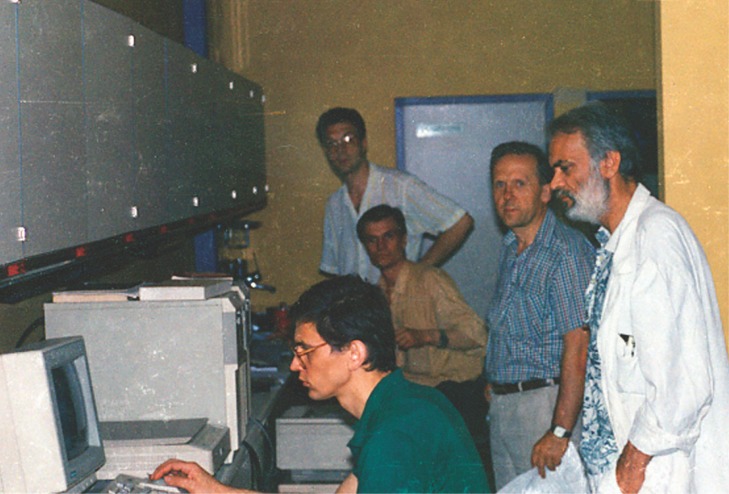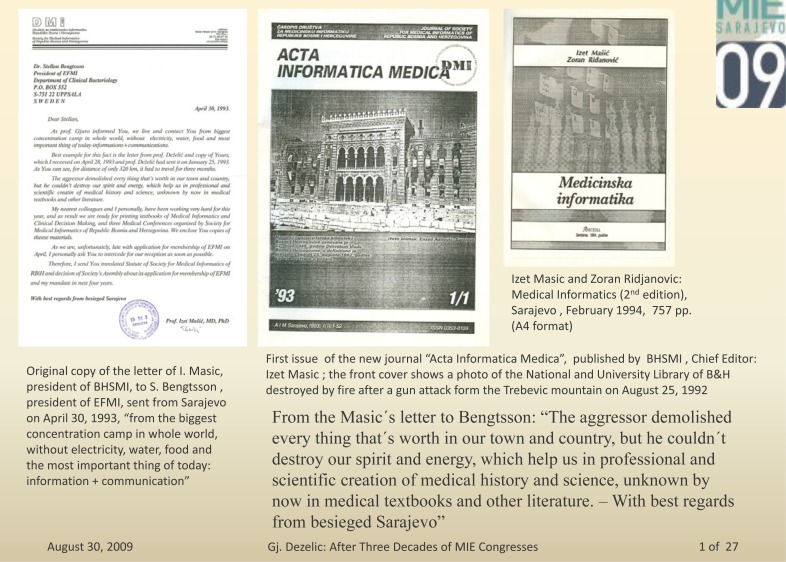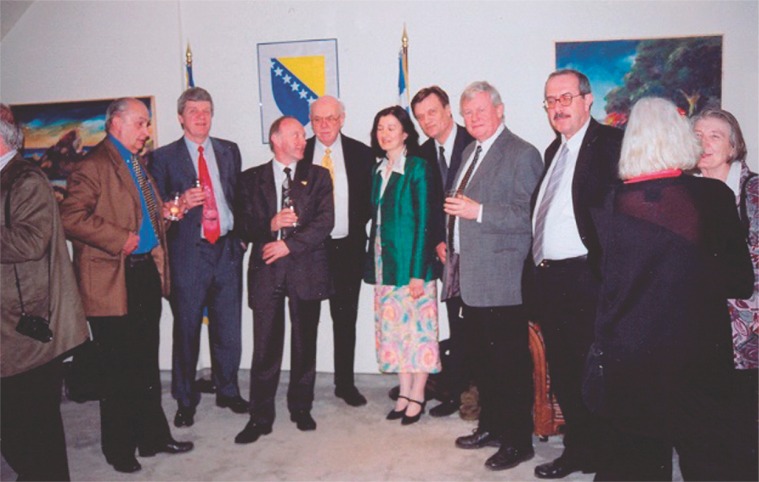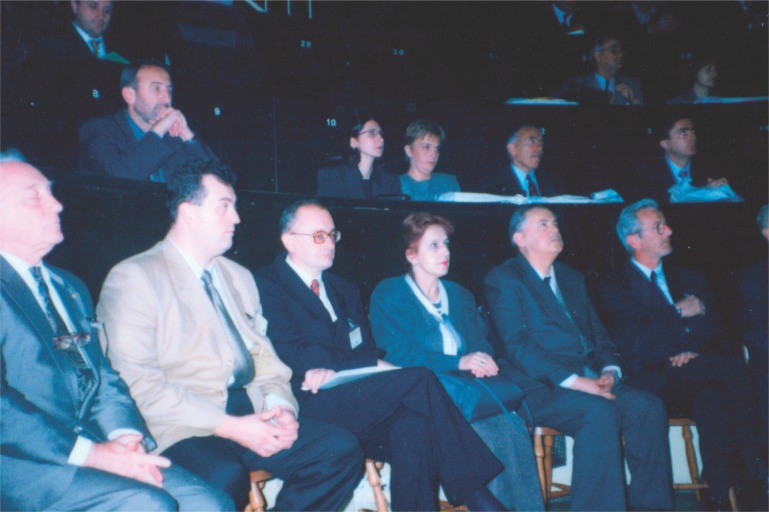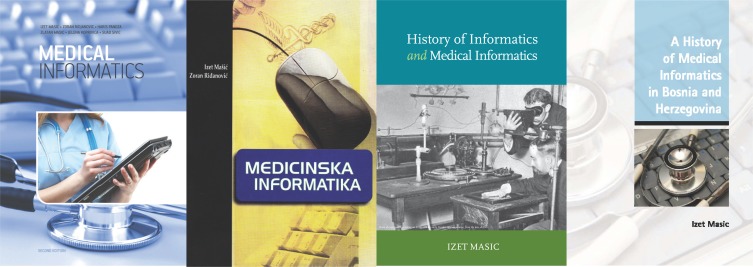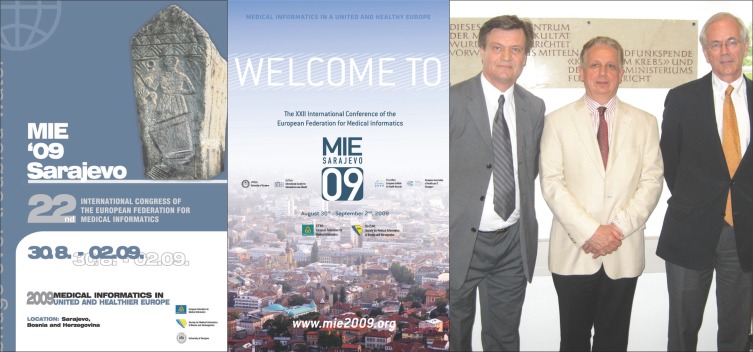Abstract
The health informatics profession in Bosnia and Herzegovina has relatively long history. Thirty five years from the introduction of the first automatic manipulation of data, thirty years from the establishment of Society for Medical Informatics BiH, twenty years from the establishment of the Scientific journal “Acta Informatica Medica (Acta Inform Med”, indexed in PubMed, PubMed Central Scopus, Embase, etc.), twenty years on from the establishment of the first Cathedra for Medical Informatics on Biomedical Faculties in Bosnia and Herzegovina, ten years on from the introduction of the method of “Distance learning” in medical curriculum. The author of this article is eager to mark the importance of the above mentioned Anniversaries in the development of Health informatics in Bosnia and Herzegovina and have attempted, very briefly, to present the most significant events and persons with essential roles throughout this period.
Key words: Medical informatics, History, Bosnia and Herzegovina.
1. INTRODUCTION
In 2012, the health informatics profession in Bosnia and Herzegovina celebrated five jubilees (1-5):
Thirty five years on from the introduction of the first automatic manipulation of data. In Sarajevo 1977, under the supervision of Fuad Secerbegovic, MD, Chief of the Department for Health Statistics, Republic Institute for Public Health BiH in, the company– “Energoinvest” Ltd. carried out the first analysis of summary and periodic health data reports about the network, capacities and performance of the healthcare service in Bosnia and Herzegovina, this analysis was previously performed manually in the above Institute. In 1982, in the Regional health station “Visnjik”, Sarajevo for the first time in the history of health within Bosnia and Herzegovina was tested Local Health Information System for approximatelly 2500 families, created by Izet Masic and Arif Agovic. Health data on services provided to 6000 users of healthcare who were treated by four teams of physicians was analysed in a software package Archive in an original Sinclair QL personal computer.
Twenty five years on from the establishment of the Society for Medical Informatics BiH. In October 1987, the above named Society was established by a group of enthusiasts and pioneers of health informatics in BiH (Izet Masic, Irfan Zulic, Arif Agovic, Marijan Dover, Mladen Novak, Zoran Kontic and others). On May 26th 1988, during the 3rd STC Conference of Medical informatics in Zagreb, Croatia, presidents of the similar societies from Croatia (Gjuro Dezelic), Slovenia (Stefan Adamic) and from Serbia (Rajko Vukasinovic) at the meeting held in the School of Public Health “Andrija Stampar” in Zagreb, signed a common memorandum of understanding and established the Association of Societies for Medical Informatics of Yugoslavia, this Association was officially registered and started to work on February 16th 1989, and in 1990 (December 6-8th) organized the First Congress of Medical Informatics in Yugoslavia, which was held in Belgrade. After the dissolution of Yugoslavia, the Association of Societies ceased to exist and in 1992 a BiH Society was registered as the Society for Medical Informatics of Bosnia and Herzegovina.
Twenty years on from the establishment of the Scientific and Professional Journal of the Society for Medical Informatics of Bosnia and Herzegovina “Acta Informatica Medica”. From the year 2008 articles published in Acta Infom Med are indexed in PubMed, PubMed Central, Ccopus and 20 other on-line databases.
Twenty years on from the establishment of the first Cathedra for Medical Informatics on Biomedical Faculties in Bosnia and Herzegovina. In October of the year 1992 the first Cathedra for Medical Informatics was established. Cathedra staff at the time comprised of the following: Asst. Professor Izet Masic, Chief of Cathedra and teaching assistants–Zoran Ridjanovic, MD and engineer Safet Jakupovic, and associates Amra Redzepovic and Ljubomir Kravec). Later cathedras for medical informatics at medical faculties in Tuzla, Banja Luka, Foca and Mostar were established. In past years the curriculum was modified and harmonized, but the basic one was the Program of Sarajevo cathedra for medical informatics. In this accademic year Medical informatics curricula consists of theoretical and practical part: 30 + 45 (Sarajevo); 60 + 90 (Tuzla); 30 + 30 (Banja Luka); 30 + 30 (Foca) and 30 + 30 (Mostar).
Ten years on from the introduction of the method of “Distance learning” in medical curriculum. In December 2002, at the Cathedra for Medical Informatics, Medical Faculty, University of Sarajevo a symposium was organised under the name “Tele-education in Biomedicine” organized to celebrate the ten-year anniversary of the establishment of the above cathedra; participants at the symposium were health informatics experts from both Bosnia and Herzegovina and Croatia. During the symposium, for the first time in the history of the University, an intra-university network was tested, this was prepared by the University Tele-information Centre – UTIC. The leader of this activity was electro-engineer Safet Jakupovic, UTIC manager. On this occasion the tele-lectoring had a duration of 90 minutes. It was the start of the project “Learning from distance in biomedicine”. Izet Masic was the leader of this project at the Medical faculty in Sarajevo, and the project was financed by funds of the cantonal Ministry of Science and Education and the Federal Ministry of Science and Education. Experiences from this project were presented at a number of world and European scientific events.
All five of the mentioned activities in the area of health informatics had special importance and gave appropriate contributions to the development of health informatics in Bosnia And Herzegovina. The Society for Medical Informatics of Bosnia and Herzegovina gathered the most eminent experts, mostly medical doctors with various specialties (we belong among countries who are members of the European Federation of Medical Informatics – EFMI, which involve the largest number of health professionals). BiH Society became a member of European Federation of Medical Informatics – EFMI during the war in 1994, and in the same year, a member of the International Medical Informatics Association – IMIA. In 2009 the Society for Medical Informatics of Bosnia and Herzegovina were given the opportunity to organize the 22nd European Congress of Medical Informatics in Sarajevo announced as “the best ever MIE”. At Sarajevo Conference participated more than 420 experts of Medical informatics from more of 40 countries from over all the word.
It should especially be pointed out that the professionals and experts of health informatics in Bosnia and Herzegovina have given important contributions to the promotion of this medical discipline through several studies and projects, from the building and realization of information systems at certain levels of healthcare to introducing modern education models in biomedicine using contemporary information technologies.
2. BEGINNINGS OF DEVELOPMENT OF HEALTH INFORMATICS IN B&H
Health (medical) informatics as a separate scientific discipline began to be effective in academic institutions at the end of the 70’s by the presentation of actual accomplishments in this area in under and postgraduate education at biomedical faculties. As a specialized discipline, health informatics has its rudiments in Bosnia and Herzegovina (B&H) in the beginning of the past century (20th), when experts, mostly graduates from the Vienna Medical Faculty, began their professional Careers in our country (6-9). Those who were more involved in the area of health statistics started to be intensely interested in the application of health technologies in health science.
Officially, health informatics has been used in B&H after the Second World War in Public health institutes on a regional level, special emphasis should go to the contribution of Fuad Secerbegovic, being manager of the department for health statistics of Public health institute of Bosnia and Herzegovina from 1972 to 1995, after Evgenije Sestnev, the first chef of that Department (1946-1971). From 1977 the automatic analysis of health data in the above institutions was introduced gradually thanks to the engagement of Fuad Secerbegovic, who has published annual reviews and summary health statistics reports in B&H and utilization of health capacities under the title “Network, capacities and services of health institutions in B&H”. The first health data was collected and processed by computers by the Company “Energovinvest” Ltd in Sarajevo during that year (1).
By the end of the 70’s of the previous century, at the University of Sarajevo Health informatics under the subject Social medicine and organization of health care as well as on postgraduate studies of the same faculty was being taught (1, 2, 3). During 1992, the first year of the War, the Cathedra for Medical Informatics was established at the Medical Faculty, University of Sarajevo, and later on at other medical faculties in Bosnia and Herzegovina with a certain number of hours of theoretical and practical education. Currently, curricula are being adapted using the principles of Bologna process and declaration.
3. HEALTH INFORMATICS IN PRACTICE IN BOSNIA AND HERZEGOVINA
Initiation, development and implementation of some informatics activities, the automatic manipulation of health data and the intensive use of information technologies for the need of diagnostics, therapy and patient rehabilitation on all levels of care in BiH health system started to be solved systematically by the end of 70’s and beginning of the 80’s. A crucial decision with a state charter was made in 1981, when the B&H government made a decision to start with work on the project “Development of B&H health information system”. Before the project, it was the completed study/analysis “Social-economical position of the health system in B&H”; based on that the B&H parliament approved the preparation of the appropriate project, this should have made modernization of the information system of health care. Basically, this project was to modernize and make automatic, the well developed and functional health statistics system in Bosnia and Herzegovina, which was part of an also well organized (centralized) Yugoslav health statistics system lead by the State Public Health Institute Belgrade. Project “Development of information system of health care B&H in circumstances of electronic data manipulation” was approved by the Executive Board of Association of healthcare communities B&H. On the 8th December 1983, eight companies applied for the tender, a contract was signed with the Intertrade Company from Ljubljana, Slovenia. In 1985 after positively assessed revisions the project was adopted and in the same year began its implementation after financial funds were assured. (Table 1).
Table 1.
Curricula of Subject of Medical informatics at Medical faculties in Bosnia and Herzegovina
 |
In 1985 the Electronic calculation centre of health and retirement insurance Sarajevo (ERC ZIPO) was established. The act itself, culminated in the establishment of a centre, was “Elaborate about social-economic finding of establishing working unit for manipulation of electronic data for health and retirement insurance fund”. For a number of years the centre was lead by engineer Mirza Ceric. Unfortunately, this very well designed project, content of activities, as well as part of completed tasks in regard to the procurement of hardware and production of software applications, has never been completed and realized in practice. The concept of centralization of data manipulation in the architecture proposed in the ZIS B&H project (central host and analysis in Sarajevo, regional analysis in eight centres in B&H and local in 109 municipalities) has never been finalized and fell down. It was utopia which has no chance to be realized in practice. It is true that some of the designed activities were started at an institutional level, but never reached their end as Clinical information system of the University clinical centre in Sarajevo, which was one of the biggest projects in area of development and construction of medical information systems. From 23 companies bidding on the tender, IRIS (eminent Company for hardware and software and part of Energoinvest Company, fourth biggest company in formal Yugoslavia) was chosen and has spent almost ten years working on the Study, Initiative design and Main project of Clinical information system of the University clinical centre in Sarajevo.
This project was also unfinished due to the War. Already procured hardware and designed software for some applications from the project (Medical subsystem, Diagnostics-polyclinic subsystem, Administrative-technical subsystem and Financial-economical subsystem) were destroyed or in the meantime lost their usefulness. The biggest progress was made in the development of information system for the pharmaceutical sector (only in Sarajevo the system connected 43 pharmacies in a centralized system of receipt collection and analysis). Besides the University clinical centre in Sarajevo, certain health institutions in Bosnia and Herzegovina started with the development of local and unique health information systems. The first Local Health Information System was created and used in Sarajevo in the year 1982 when Izet Masic and Arif Agovic tested special designed Health data bases for the supervision of approximately 6.000 citizens – users of health care services at the Community health centre “Visnjik” in Sarajevo. Health data was processed by a specially designed software package ARCHIVE on a Personal Sinclair QL computer, later redesigned in Clipper and DBASE III and FoxBASE. After 3 years of testing those data bases Izet Masic graduated first master thesis within Health informatics – it was the first defended master thesis in that field in any of the Balkan countries. During the war (1992-1995), and after the war, a lack of appropriate financial funds, and many other factors inf luenced the interruption of the planned activities, especially, having in mind how those activities were recommended in project plans regarding system development and perception.
The Ministry of Health and Social Welfare of Socialistic Republic B&H set up a Commission for a health information system. The Commission was put in charge to assess the above projects, concept, content of data necessary to collect, methods and methodology, information flow, functionality, rationality and efficiency. The Chair person for the Commission was Izet Masic and members were: Irfan Zulic, Zoran Ridjanovic, Gojko Babic, Nedzad Mehic, Stevica Krsmanovic, Mirza Ceric, Mustafa Hasovic and Naim Grebo. This Commission was very successful, but in the last ten structures of the Ministry of Health there is no such body.
4. HEALTH INFORMATICS IN MEDICAL EDUCATION
The need for additional education of health professionals was realised after the first application of electronic data manipulation. For physicians in primary health care and in clinics, in order to perform their duties in a high quality manner, must have been up to date with the latest accomplishments in medicine and health. Since the 60’s the development of information technologies has had a quantitative and qualitative growth especially in diagnostics and therapy, and health workers had to follow that. Great role in this field had IMIA – International Medical Informatics Association and EFMI – European Federation for Medical Informatics. Working groups of IMIA and EFMI recommended and defined concepts and methodologies of education for medical informatics on three levels (3, 4, 5, 6).
First, informatics education which should provide general knowledge to users and data analysis on the place of their generation, and on all places of collecting data in health system (physicians of all specializations, nurses and paramedical staff).
Second level, informatics education of this level is in regard to medical staff which was directly involved in collection, manipulation, analysis and interpretation of health data. This kind of education was expanded with skills, knowledge and practical applications which are necessary for personnel on this level.
The Third level is basically a very wide and highly specialized education for experts in the health sector who would like to be professionally involved in this kind of work. In B&H there has never been an accepted proposal for introducing subspecialization from medical informatics in spite of the fact that authors of this paper put a lot of effort and energy into making it official. It is a fact that at some universities in European countries there are separate faculties or universities for graduates withthe title of engineers of health informatics.
There are five medical faculties in Bosnia and Herzegovina (Sarajevo, established in 1946; Tuzla, established in 1976; Banja Luka, established in 1986; Foca, established in 1994; and Mostar, established in 1997). At all the faculties, since 1992 and later, cathedras for medical informatics were established and/or introduced as independent subjects: medical informatics or health informatics, bioinformatics, etc. In principle, 60-70% of the curriculum are the same, or very similar; the only difference is that the chiefs of some cathedras are medical doctors and of others are professors, engineers, mathematicians or economists with the title of MSc or PhD in this area. Most of those cathedras have web sites where students can check the number of hours and content to be taught.
Openly speaking in undergraduate education until 1992 when medical informatics was introduced as an independent subject at the Medical Faculty, University of Sarajevo just some lectures were taught; those were methodological units in that time very important for health practice (medical documentary with two teaching hours and health information systems also two teaching hours) under the subject of Social medicine and organization of health care and Professor Izet Masic. from 1979 on Postgraduate education at the Medical Faculty, University of Sarajevo there were subject Health informatics led by the pioneer of health informatics in ex-Yugoslavia Prof Gjuro Dezelic, PhD using concept, content and methodology at the Medical Faculty, University of Zagreb. In the school year 1970-1971 at the Medical Faculty, University of Zagreb was introduced “Basic Informatics” (named Use of electronic computers in health care) as obligatory subject for 6th semester students with a duration of 15 school hours. A similar programme was at postgraduate studies at the same faculty under the subject “Introduction in scientific work”. In 1973 a separate cathedra for “Basics of Informatics” was established since it was obvious to make a distinction between those two areas. Both, under and postgraduate students had the chance to attend “Techniques of programming electronic computers” for a duration of 20 school hours. In 1973 the subject at postgraduate studies “Analysis of health data by methods of informatics and statistics” for a duration of 20 hours it was introduced.
Since 1985, Professor Izet Masic took over the leader position and with the help of Professor Gjuro Dezelic and Professor Arif Smajkic launched a separate course “Informatics and Economics in Health” for a total duration of 30 hours. Numbers of postgraduate students became MSc and PhD in this subject, and some of them became professors and assistants in B&H universities and abroad. Since 1992 at the Medical Faculty, University of Sarajevo there have been Cathedra for Medical Informatics. The content of education is 30 hours of theoretical and 45 hours of practical education for students of the Medical Faculty, 15+15 hours for students of Faculty of Dental medicine and 30+30 hours for students of College of Noursing. From 2002 the subject is split into two parts: Basics of medical informatics with funding of 15+15 hours in the second semester of studies and Applicative medical informatics with funding of 15+45 hours in the eleventh semester. The final exam is due after the 11th semester. Curriculum, teaching materials, application for the exam, the exam itself and checking of results are possible at the web site (www.imasic.org). Also, since 2002 at Cathedra for Medical informatics the project “Distance learning in biomedicine” is in progress which allows students to use an electronic way of learning and to pass their exams in this subject. This method of education is in a pilot phase and waiting for official approval from the appropriate institutions in charge for high education. In total, education from Medical informatics gained 2500 students. At postgraduate students of The Medical Faculty, University of Sarajevo there are subject Medical Informatics with funding of 15+15 hours and this type of education enabled over 800 medical doctors all medical specializations. In progress is the adaptation of curriculum of neighbouring countries in Medical informatics and content of methodological units with the Bologna process.
5. BOSNIA AND HERZEGOVINA HEALTH INFORMATICS AT INTERNATIONAL LEVEL
All the above mentioned activities could not have been realized in practice without strategies and concepts developed by professionals and experts in the area of medical informatics. In the early 80’s, first in Sarajevo, then in other towns within Bosnia and Herzegovina, mostly engineers of electro-technique start to be intensely interested for some segments of health informatics; some of them managed certain projects, besides others they were involved in preparation of design of software applications for the mentioned project ZIS B&H. They have been followed by ambitious physicians who could see in the new information technologies a future and practical help in performing their everyday jobs. Pioneers in this area were: Izet Masic, Zoran Ridjanovic, Benjamin Djulbegovic, Sead Beganovic and others who attended professional meetings and workshops with appropriate topics from medical informatics. They were supported by Professor Abdulah Konjicija who in 1984 started to introduce mathematical models in diagnostics and therapy of certain diseases, and altered with mentioned experts algorithms for curing the phases of a disease.
Later, those experts began to work more closely on some parts of the medical informatics for which they had an affinity. Some of them have prepared papers and presentations for specially organized symposiums “B&H days of informatics” held annually on the mountain of Jahorina near Sarajevo from the year 1976. In October 1987 a group of experts within the field of Medical informatics decided at General Assembly to set up an independent Society for medical informatics of Bosnia and Herzegovina which was joined with similar independent societies from Croatia, Slovenia and Serbia (established at General assembly on February 16th 1989 at Andrija Stampar School in Zagreb, Croatia) as the Association of societies for medical informatics of Yugoslavia.
The President of the Association board was Gjuro Dezelic, and members were Stefan Adamic, Rajko Vukasinovic and Izet Masic. In 1990 this association became a member of the European Federation for Medical Informatics and was officially accepted on the EFMI Council in Glasgow. The EFMI Council in Glasgow was attended by Gjuro Dezelic and Izet Masic who, in the same year, organized the First Congress of Medical Informatics in the Sava centre in Belgrade on December 6th-8th which was opened by the EFMI president (at the time) Stellan Bengtsson. Over 500 delegates attended the First Congress of Medical Informatics (Figure 1, 2 and 3).
Figure 1.
Founders of Society for Medical informatics of B&H in Sarajevo.
Figure 2.
Slide presented by prof. Gjuro Dezelic, pioneer of Medical informatics in former Yugoslavia at MIE 2009 Conference in Sarajevo during Opening Ceremony.
Figure 3.
Reception of EFMI Council members (meeting in Athens) at Embassy in Athens (March 2005) - up; Ragnar Nordberg (Sweden), Robert Baud (Switzerland), Bernd Blobel (Germany), John Bryden (UK); Saida Fisekovic, vice-ambasador (BiH), Izet Masic (BiH), Arie Hasman (The Netherlands) and John Mantas (Greece) (from the left to the right).
In 1991 this association fell apart and each member established society at the level of new recognized states. The BiH society during the war year of 1992 became an independent professional organization and first of its kind in the independent state of Bosnia and Herzegovina. In the same year a group of society members (Izet Masic, Zoran Ridjanovic, Irfan Zulic, Aziz Hodzic, Zelimir Nastic, Ljubomir Kravec, Marijan Dover, etc.) kicked off the initiative for acceptance of the Society for Medical Informatics B&H in the European Federation for Medical Informatics. In 1994 the Society for Medical Informatics B&H became a member of the EFMI (EFMI Council decision in Lisbon) and IMIA (the Decision of the General Assembly in Dresden). It should be pointed out that much gratitude for those acceptances must go to President Stellan Bengtsson and Gjuro Dezelic, who, during unbelievable war conditions, carried out preactivities over radio links with the establisher and first president of SMI B&H, Izet Masic. This was the only possible link from Sarajevo in that time. During incredible war conditions an official delegation (Izet Masic and Zoran Ridjanovic) attended the EFMI Council and were present at the official ceremony of this distinguished scientific association.
The War period (1992-1995) in Bosnia and Herzegovina Society for Medical Informatics was spent working very hard and in almost impossible conditions eight scientific and professional events were organized. At those events over 500 papers were presented which were published from the proceedings, which at that time was a real miracle and fantastic achievement having in mind that Sarajevo was under what was to be the longest siege any City has endured in history, added to this a severe lacking in electricity, water supply, gas and food. The siege of Sarajevo was to last for Approx: 1245 days without a break. Those materials found their way across Europe and they were recognized as a Sarajevo miracle at the time.
Serious activities of the Society follow on local and international level. The Society has organized a number of professional symposiums (eight in total so far) on the actual themes of:
Classification systems in Health care system, December 1992;
History of Health and Social culture in B&H, march 1993;
Health information systems, December 1993;
War medicine and medicine in a war, November 1993;
War medicine and medicine in a war, November 1994;
Medical documentation and evidence, November 1996;
Tele-education in biomedicine, December 2002;
eHealth and eEducation, December 2005.
The Society also organized the First congress of Medical Informatics of Bosnia and Herzegovina with international participation, held in Sarajevo in November 1999 and attended by 70 participants (from B&H, Croatia, Slovenia, Serbia and Montenegro, Macedonia, Norway, etc.) and officially opened by Professor Attila Naszlady (Figure 4).
Figure 4.
Participants of First Congress of Medical Informatics of B&H, held in Sarajevo, on November 5th 1999 (professors: Attila Naszlady, Faris Gavrankapetanovic, Bozo Ljubic, Zehra Dizdarevic, Seid Hukovic, Nedzad Mulabegovic, Husein Kulenovic, sitting, from the left).
The Second congress of Medical Informatics with international participation, organized in Sarajevo in May 2004 was officially opened by Professor Assa Reichert, president of the EFMI where 90 delegates from BiH, Croatia, Slovenia, Canada, Israel, Switzerland, Holland, United Kingdom, Germany, Norway, etc. Attended. During the congress the EFMI held a meeting of the EFMI Board, which consisted of: Assa Reichert, president; Robert Boaud, vice president; Jacob Hofdijk, secretary; Rolf Engelbrecht, vice president IMIA; Johan Bryden, executive officer; Patrick Weber, treasurer. Members of the Board carried out an official visit to Bosnia and Herzegovina with regard to SMI BiH and the City of Sarajevo for the organization of MIE2009. At the next meeting of the EFMI Council held in Munich in June 2004, the Board made a positive decision on the application and recommended to SMI BiH the preparation of the BID book for the following EFMI Council. Finally, on the EFMI Council meeting in Athens held on 18 March 2005, an official decision was made that Sarajevo will be the host of the MIE2009 to be held in Sarajevo (1, 2, 3).
The SMI BiH also organized a Special Topic Conference named “eHealth and eEducation” in the premises of the rector of Sarajevo University on 20th December 2005. During the conference Professor Rolf Engelbrecht, as key speaker, held a tele-conference from Munich, Germany on “Tele-medicine in Germany”. It was the very first tele-lecture from biomedicine organized by our society. The event was organized with the support of ERICSSON and the International Society for tele-medicine and eHealth having in mind that the SMI BiH becomes an official member of the ISfTeH and Izet Masic a member of the ISfTeH Governing Council.
6. MEDICAL INFORMATICS IN BOSNIA AND HERZEGOVINA IN SCIENCE AND RESEARCH
SMI BiH after establishing in 1993 launched the professional and scientific journal Acta Informatica Medica (Acta Inform Med) and it has been published continuously for the past 20 years. At first journal was published twice a year, then three times a year, since 2005 quarterly and from this year bimonthly. The Journal has abstracted and indexed in more than 20 on-line databases. So far, it has published over 1.000 scientific papers, articles, editorials, case studies, and various actualities. The first Editorial Board in 1993 were: Izet Masic (editor-inchief), Zoran Ridjanovic (assistant of editor-in-chief), Amra Redzepovic (secretary), Ljubomir Kravec (technical editor), Georgina Janjic (lector), Tatjana Prastalo (English translation). Editorial board members were: Kenan Arnautovic, Meho Basic, Mahmut Djapo, Zoran Hadziahmetovic, Dragan Huml, Mehmed Kantardzic, Mustafa Kulenovic, Nedzad Mehic, Miroslav Polomik, Nikola Rukavina, Borisa Telebak, Irfan Zulic.
Teachers and associates involved in the education of students on post and undergraduate studies on biomedical faculties in Bosnia and Herzegovina during the past 20 years published a number of books, monographies, and other publications, some of which, have been translated into the English language (Figure 5). Also, BiH experts for medical informatics participate enthusiastically at European and world congresses of medical informatics with oral presentations or poster presentations. This is an opportunity to mention just some of the more important publications: Medical informatics I, by Izet Masic, Zoran Ridjanovic, 1994; Practicum for medical informatics by Izet Masic, Haris Pandza, 2000; Health ethics and data protection by Izet Masic, Zoran Ridjanovic, 2001; Medical informatics II by Izet Masic, Zoran Ridjanovic, 2001. Medical Informatics - English version by Izet Masic, Zoran Ridjanovic, Haris Pandza, Zlatan Masic (2010), History of Informatics and Medical Informatics by Izet Masic (2013). Izet Masic and Ahmed Novo are also co-authors in a book “Advances in International Tele-medicine and eHealth around the world” edited by Wojciech Glinkowski (2006). An important part of medical informatics in Bosnia and Hercegovina has to be underlined- this is the System of biomedical scientific and professional information (Library system in BiH-SBMNI), developed by the group of medical librarians and informatics professionals in BiH (Ana Gerc, coordinator, librarians: Amila Colakovic, Tanja Benic, Jelena Koprivica, Miljenko Krsmanovic etc..) during the period 1984-1990. That SBMNI was a part of the Yugoslavian system of biomedical informing, established 1980 in Belgrade, known as Biomedicina Iugoslavica, in other words Index Medicus Iugoslavicus as a secondary periodic publication. This was like a continuing work of Index Medicus Iugoslavicus (1966-1983) published by the General hospital »Dr. J. Kajfes», Zagreb and Biomedicina Slovenica published by the Institute for biomedical informatics Ljubljana since 1976. Scientific and professional articles published in indexed journals in former Yugoslavia were stored in computer host “System of biomedical, scientific and research information”, called Index Medicus Iugoslavicus/Biomedicina Iugoslavica. It included professional papers, monographies, master and PhD thesis, scientific reports and other similar documents published in the country and aboard. Gathering and editing documents was performed using the well known rules in SBMNI, based on MEDLARS standards in English.
Figure 5.
Cover pages of the books: Medical informatics (English version), Medicinska informatika (Bosnian version); History of Medical informatics.
7. MIE 2009 CONFERENCE IN SARAJEVO
The MIE 2009 Conference was organized by the European Federation of Medical Informatics – EFMI and Society of Medical Informatics of Bosnia and Herzegovina – BHSMI in Sarajevo from August 30th to September 2nd of the year 2009. Venue place was prestigous hotel Holiday Inn in Sarajevo (Figure 6 and 7). The Conference gathered participants all over the world, altogether 931 researchers have reported their results in this volume. During the same Conference, joined conferences were organized: BHSMI Special Track and EUROREC Conference 2009. Proceeding of the MIE 2009 Conference (1064 pages) was printed by IOS Press, Amsterdam and contains 213 contributions to the MIE 2009 Conference – 150 full presentations, 21 student paper presentations, 21 presentations presented at MIE 2009 as poster presentations and 14 workshop descriptions. Also, in Proceedings were included papers from 9 invited speakers: Gjuro Dezelic: After Three Decades of Medical Informatics Europe Congresses; Gerard Comyn: EU eHealth Agenda Strengthening Research and Innovation; William Edward Hammond: Realizing the Potential of Healthcare Information Technology to Enhance Global Health; Rolf Ewers: Augmented Reality and Telenavigation in Cranio and Maxillophacial and Oral Surgery; Mordechai Shani: The Use of ICT in the Delivery of Healthcare Services to the Chronic Patient; Reinhold Haux: Health Enabling Technologies for Pervasive Health Care: a Pivotal Field for Future Medical Informatics Research and Education; Andrew Ballas: Interoperative Electronic Patient Records for Health Care Improvement; Blackford Middleton: Clinical Decision Support and Sylwia Miksch: Computer Based Medical Guidelines and Practice: Current Trends.The papers included were selected by an International Scientific Programme Committee (SPC) out of 324 submissions after careful review by three international reviewers for every single submission. The SPC chair and his two co-chairs (Klaus Peter Adlassnig, Bernd Blobel and John Mantas) did great job and all papers are indexed in PubMed/Medline databasis.
Figure 6.
Posters of Medical Informatics in Europe (MIE) 2009 Conference in Sarajevo, 2009 (left); Izet Masic, Klaus Peter Adlassnig and Jacob Hofdijk, chairs of MIE 2009 conference in Sarajevo (from left to right).
Figure 7.
MIE Conference in Sarajevo: a) Opening ceremony; b) LOC staff; c) Participants of one of the main sessions (Sarajevo, 2009).
Most of the topics presented at MIE 2009 are interdisciplinary in nature and may be of interest to a variety of professionals: medical informatics, bioinformatics, health informatics scientists, medical computing and technology specialists, public health, health insurance and health institutional administrators, physicians, nurses, and other allied health personnel, and representatives of industry and consultancy in the various health fields.
There are several trends and developments that can be recognized by carefully examining the single contributions to the various topics. First, interoperability and data exchange standards become most important. Systems must be interconnected to each other: locally, nationally, and transnationally. Second, ontologies (“those that is”) are being developed in an increasing path. By doing so, medical vocabulary that is used in an application, as well as the semantics of applied items is defined. Third, Web apllications allow to share medical information and knowledge by many users - researchers, staff and patients. Fourth, clinical decision support systems provide huge impact on medical workf low and patient care to the benefit of patient, the caring physician, and the financing health care bodies (6-12).
The great variety of scientific topics and countries that were presented, made MIE 2009 Conference in Sarajevo a huge success and a fruitful study of proceedings by those interested in Medical Informatics.
8. FUTURE OF MEDICAL INFORMATICS IN B&H
Teaching staff performed a number of surveys analysing current levels among medical students and health professionals. Key activity of the B&H SMI will be to enhance efforts on reconstructing a high education system in the country in accordance with the Bologna process. There are two areas which the focus of activities needs to be directed: under and postgraduate education and continuous medical education (CME) for health workers, medical doctors as well as nurses.
CONFLICT OF INTEREST
NONE DECLARED.
REFERENCES
- 1.Masic I. History of Informatics and Medical informatics. Sarajevo: Avicena; 2013. pp. 59–100. [Google Scholar]
- 2.Masic I. History of Medical Informatics in Bosnia and Herzegovina. Sarajevo: Avicena; 2007. pp. 11–64. [Google Scholar]
- 3.Masic I. International Journal of Medical Informatics. 50. Vol. 123. Elsevier Science Ireland Ltd; 1998. Education of medical informatics in Bosnia and Herzegovina; pp. 95–101. [DOI] [PubMed] [Google Scholar]
- 4.Hasman A, Mantas J, Zarubina T. An Abridged History of Medical Informatics Education in Europe. Acta Inform Med. 2014 Feb;22(1):25–36. doi: 10.5455/aim.2014.22.25-36. doi: 10.5455/1im.2014.22.25-36. [DOI] [PMC free article] [PubMed] [Google Scholar]
- 5.Mihalas G. Evolution of Trends in European Medical Informatics. Acta Inform Med. 2014 Feb;22(1):37–43. doi: 10.5455/aim.2014.22.37-43. doi: 10.5455/aim.2014.22.37-43. [DOI] [PMC free article] [PubMed] [Google Scholar]
- 6.Dezelic Gj. After Three Decades of Medical Informatics Europe Congresses. Stud Health Technol Inform. 2009;150:3–7. [PubMed] [Google Scholar]
- 7.Masic I, Ridjanovic Z. Medical Informatics. Sarajevo: Avicena; 2010. pp. 5–34. [Google Scholar]
- 8.Glinkowski W, et al. Around the world. Warsaw: MedPage Ltd; 2006. Advances in International Telemedicine and eHealth; pp. 28–36. [Google Scholar]
- 9.Masic I, Ridjanovic Z. Medicinska informatika – jucer, danas, sutra. Acta Inform Med. 1993;1(1):13–19. [Google Scholar]
- 10.Masic I, Ridjanovic Z. Razvitak zdravstvene informatike u Bosni i Hercegovini. Acta Inform Med. 1993;1(1):21–22. [Google Scholar]
- 11.Masic I. Telematika u medicini - perspektive razvoja u BiH. Med Arh. 1995;49(3-4):69–70. [PubMed] [Google Scholar]
- 12.Masic I. Prvi kongres medicinske informatike BiH - Novi izazovi. Med Arh. 1999;53(4, supl.3):3–4. [Google Scholar]



